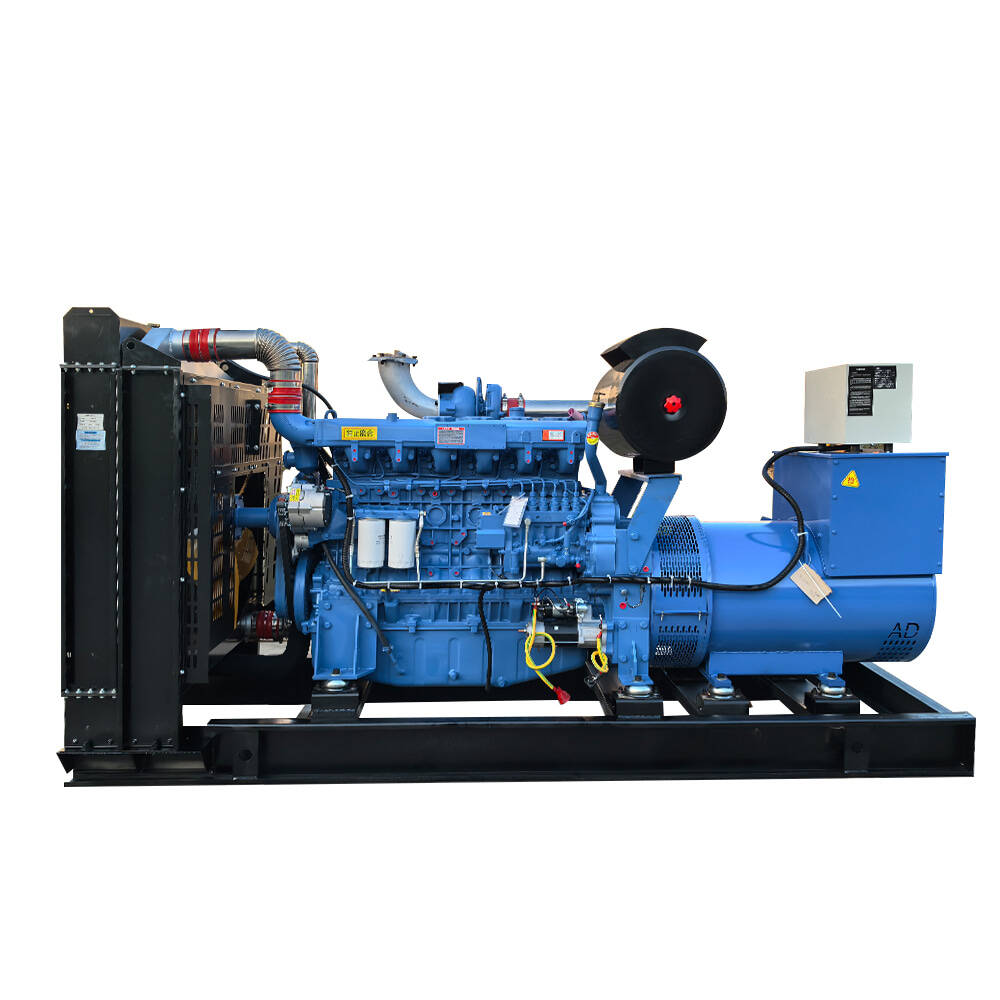When selecting power generation equipment for industrial or commercial applications, understanding the quality standards that govern generator manufacturer operations becomes crucial for making informed purchasing decisions. The power generation industry relies heavily on stringent manufacturing protocols to ensure equipment reliability, safety, and performance consistency across diverse operating environments. These standards not only protect end users but also establish the foundation for long-term equipment durability and operational efficiency.

Modern power generation facilities demand equipment that meets international certification requirements while maintaining cost-effectiveness and operational reliability. The complexity of today's electrical systems requires manufacturers to adhere to multiple quality frameworks simultaneously, creating comprehensive assurance protocols that span from raw material selection through final product testing and validation.
International Certification Standards for Power Generation Equipment
ISO Quality Management Systems
The International Organization for Standardization provides the foundational framework that most reputable generator manufacturer companies follow to ensure consistent product quality and customer satisfaction. ISO 9001 certification specifically addresses quality management systems, requiring manufacturers to demonstrate systematic approaches to design, production, and service delivery processes.
This certification demands rigorous documentation of manufacturing procedures, continuous improvement protocols, and customer feedback integration mechanisms. Companies maintaining ISO 9001 status must undergo regular audits and demonstrate measurable improvements in their quality management approaches over time.
Beyond basic quality management, ISO 14001 environmental management standards have become increasingly important for generator manufacturer operations, especially as sustainability concerns influence purchasing decisions across industrial sectors. These standards ensure that manufacturing processes minimize environmental impact while maintaining product quality and performance specifications.
Electrical Safety and Performance Certifications
UL (Underwriters Laboratories) certification represents one of the most recognized safety standards in North American markets, covering electrical safety, fire hazard assessment, and performance verification for power generation equipment. This certification process involves extensive testing of electrical components, insulation systems, and protective mechanisms.
European markets typically require CE marking compliance, which demonstrates conformity with health, safety, and environmental protection standards applicable within the European Economic Area. The CE marking process involves comprehensive technical documentation and often requires third-party assessment and ongoing surveillance.
IEC (International Electrotechnical Commission) standards provide globally recognized specifications for electrical equipment performance, safety requirements, and testing methodologies. These standards ensure that generator manufacturer products can operate safely and effectively across different electrical grid configurations and environmental conditions.
Manufacturing Process Quality Control
Material Selection and Incoming Inspection
Quality control begins with rigorous material selection processes where manufacturers establish approved vendor lists and incoming inspection protocols. Raw materials such as steel, copper, aluminum, and specialized electrical components must meet predetermined specifications before entering the production process.
Advanced generator manufacturer facilities employ automated inspection systems that verify material dimensions, chemical composition, and physical properties against established parameters. These systems reduce human error while ensuring consistent material quality throughout the production cycle.
Traceability systems track materials from receipt through final product assembly, enabling rapid identification and resolution of quality issues should they arise during production or after delivery to customers. This systematic approach supports both quality assurance and regulatory compliance requirements.
Production Line Quality Assurance
Modern manufacturing facilities implement multiple quality checkpoints throughout the production process, with trained technicians conducting visual inspections, dimensional verification, and functional testing at predetermined intervals. These checkpoints help identify potential issues before they propagate through subsequent manufacturing stages.
Statistical process control methods enable manufacturers to monitor production trends and identify variations before they result in non-conforming products. This proactive approach reduces waste, improves efficiency, and ensures consistent product quality across production runs.
Automated testing equipment performs electrical continuity checks, insulation resistance measurements, and preliminary performance verification during assembly processes. This integration of automated testing with manual inspection creates comprehensive quality assurance coverage throughout manufacturing operations.
Testing and Validation Protocols
Factory Acceptance Testing
Comprehensive factory acceptance testing represents the final quality verification step before equipment ships to customers. These tests simulate actual operating conditions and verify that all systems function according to design specifications and customer requirements.
Performance testing includes load verification, voltage regulation assessment, frequency stability measurement, and efficiency validation across the full operating range. Environmental testing may include temperature cycling, humidity exposure, and vibration resistance depending on the intended application.
Documentation generated during factory acceptance testing provides customers with verified performance data and serves as the baseline for warranty coverage and future service requirements. This documentation also supports regulatory compliance and insurance requirements in many applications.
Long-term Reliability Testing
Leading generator manufacturer companies invest in extended reliability testing programs that simulate years of operation in accelerated timeframes. These programs help identify potential failure modes and design weaknesses before they affect customer operations.
Accelerated life testing subjects components to elevated stress levels including temperature, humidity, electrical load, and mechanical vibration to predict long-term performance and identify optimal maintenance intervals. Results from these tests inform both design improvements and customer maintenance recommendations.
Field performance data collection from installed equipment provides real-world validation of laboratory testing results and enables continuous improvement of both products and testing methodologies. This feedback loop ensures that quality standards evolve with changing application requirements and operating conditions.
Regulatory Compliance and Industry Standards
Environmental Regulations
Environmental regulations significantly influence generator manufacturer design and testing requirements, particularly regarding emissions control, noise levels, and fuel efficiency. EPA regulations in the United States and similar standards in other regions establish specific limits for various pollutants and operational parameters.
Compliance testing must demonstrate that equipment meets these environmental standards under various operating conditions and throughout the expected service life. This testing often requires specialized facilities and certified testing procedures to ensure accuracy and regulatory acceptance.
Documentation requirements for environmental compliance include detailed emissions data, noise level measurements, and fuel consumption specifications. This information must be readily available to customers and regulatory authorities throughout the equipment lifecycle.
Grid Integration Standards
Electrical grid integration requirements vary by region and application, necessitating comprehensive understanding of local utility standards and grid codes. These requirements address power quality, synchronization capabilities, and protective system coordination.
IEEE standards provide technical specifications for power generation equipment interconnection, including voltage and frequency regulation, harmonic distortion limits, and protection system requirements. Compliance with these standards ensures safe and reliable grid integration.
Utility interconnection requirements often mandate specific testing and documentation before equipment can be connected to the electrical grid. Generator manufacturer companies must ensure their products meet these requirements and provide necessary documentation to facilitate customer interconnection processes.
Quality Assurance Beyond Manufacturing
Service and Support Infrastructure
Quality standards extend beyond manufacturing to encompass service and support capabilities that ensure long-term equipment performance and customer satisfaction. This includes technical support accessibility, parts availability, and service technician training programs.
Comprehensive service documentation and troubleshooting resources enable customers and service technicians to maintain equipment effectively throughout its operational life. Regular updates to service procedures and technical bulletins ensure that support information remains current with evolving technology and application requirements.
Parts quality and availability directly impact equipment reliability and customer satisfaction. Leading manufacturers maintain extensive parts inventory systems and establish quality control procedures for replacement components that match or exceed original equipment specifications.
Continuous Improvement Programs
Effective quality management requires ongoing evaluation and improvement of products, processes, and services based on customer feedback, field performance data, and technological advances. This systematic approach ensures that quality standards evolve with changing market requirements and technological capabilities.
Customer feedback systems collect and analyze performance data, service requirements, and satisfaction metrics to identify opportunities for product and service improvements. This information guides research and development priorities and helps prioritize quality enhancement initiatives.
Technology advancement integration ensures that new materials, manufacturing techniques, and design methodologies are evaluated and implemented when they provide measurable quality or performance benefits. This proactive approach maintains competitive advantages while ensuring continued compliance with evolving standards.
FAQ
What certifications should I look for when selecting a generator manufacturer
Look for ISO 9001 quality management certification, UL or CE safety certifications depending on your location, and relevant environmental certifications such as EPA compliance. Additionally, verify that the manufacturer maintains current certifications from recognized testing laboratories and industry organizations relevant to your specific application requirements.
How do quality standards affect generator pricing and value
While certified equipment may carry higher initial costs, quality standards typically provide better long-term value through improved reliability, lower maintenance requirements, and extended service life. Additionally, certified equipment often provides better warranty coverage and insurance qualification, reducing total cost of ownership over the equipment lifecycle.
What documentation should manufacturers provide to demonstrate quality compliance
Reputable manufacturers should provide certification documents, test results, material certifications, and detailed technical specifications. This documentation should include factory acceptance test results, environmental compliance data, and warranty terms that reflect confidence in product quality and performance capabilities.
How often are quality certifications updated or renewed
Most quality certifications require annual surveillance audits with full recertification every three years. However, specific requirements vary by certification type and issuing organization. Customers should verify that manufacturers maintain current certifications and can provide documentation of ongoing compliance with applicable standards.
